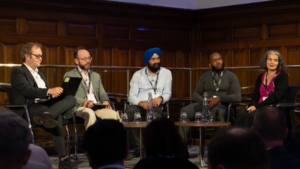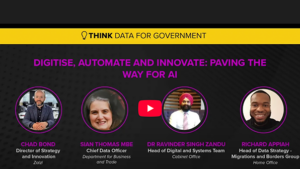
Escaping government legacy technology is like Tetris… but not as you know it
I expect you’ve heard this analogy before. Perhaps you’ve even used it yourself to describe that feeling of constant pressure as you try to fit new digital demands onto a creaking foundation of government legacy technology. The idea of IT strategy as a game of Tetris is a powerful one — and it’s been doing the rounds for some time.
I’ve walked the halls of Whitehall both as a civil servant and now as a supplier. And I can tell you this: the game’s changed. The speed’s cranked up. The shape of the blocks is different. And new power-ups have emerged that fundamentally alter the rules.
The 2025 game-changers: New pieces, new physics
The core challenge remains: you have a board already crowded with legacy blocks and a stream of new digital demands falling from above that you must expertly slot in — and mixed in with these are rogue shadow IT pieces.
But three revolutionary changes have altered the physics of the game.
1. The AI block: Your biggest opportunity and threat
The single biggest change in recent years is the explosion of Generative AI. This isn’t just another falling block; it’s a polymorphic, unpredictable piece that can change shape mid-air.
- As an opportunity, it’s the ultimate ‘line-clearing’ tool. AI can analyse and refactor legacy code, translate ancient programming languages, and automate testing, dramatically accelerating your modernisation efforts.
- As a threat, it’s the most dangerous form of shadow IT you’ve ever faced. Staff using unsanctioned AI tools to write code, analyse sensitive data, or communicate with citizens can introduce profound security holes, data privacy nightmares, and algorithmic bias that your department will be held accountable for.
2. The platform power-up: Reshaping the board Itself
The most forward-thinking departments in 2025 are no longer just playing blocks; they are strategically re-engineering the game itself. This is the rise of mature platform engineering. It’s about building a stable, automated foundation—a set of “Paved Roads”—that makes it incredibly easy for your teams to do the right thing. This platform provides the common components (identity, payments, cloud hosting, security monitoring) so service teams can build and deploy new, compliant digital services at a speed unimaginable just a few years ago.
3. The economic “gravity”: No time for mistakes
The post-COVID economic climate and relentless pressure on public finances have increased the “gravity” in our game. Blocks are falling faster. The political and public tolerance for multi-year, multi-billion-pound IT transformation projects that fail to deliver immediate value is zero. You’re expected to clear lines—to show tangible results—far more frequently. This fiscal reality fundamentally challenges the wisdom of slow, sequential replacement strategies.
How to play in 2025: Managing government legacy technology
A complete overhaul isn’t always feasible. But that doesn’t mean you’re stuck. The new rules of the game are about strategic, surgical interventions.
From ‘tolerate’ to ‘actively contain’
In the past, you could “tolerate” a stable, non-critical legacy system. In 2025, that’s dangerously complacent. An unpatched but previously isolated system can become your biggest vulnerability when a staff member inadvertently connects it to an unsanctioned AI tool.
The new rule: No system is an island. “Tolerable” systems must be actively contained. It means putting them in a secure enclosure, strictly controlling all data flowing in and out, and continuously monitoring them for anomalous activity. You must have a clear, costed, and regularly reviewed plan for their eventual decommissioning, even if it’s years away.
- Example in practice: Following a near-miss where a legacy HR system was almost exposed via a shadow AI plug-in, a major department initiated an “Active Containment” programme. They used modern tools to create a security wrapper around the old system, logging every single access request and using AI to spot unusual patterns, effectively buying them time to plan a safe replacement while neutralising the immediate threat.
From ‘optimise’ to ‘augment & automate’
“Optimise” used to mean a “lift and shift” to the cloud. It was a good first step but it’s no longer enough. The 2025 approach is to use new tools to fundamentally enhance your existing assets.
The new rule: Use AI and automation to augment your systems and teams. This means using AI-powered tools to automatically refactor and modernise codebases, cutting down multi-year projects to months. It means wrapping legacy systems not just with basic APIs, but with intelligent APIs that can clean, validate, and enrich data on the fly.
- Example in practice: The Department for Work and Pensions (DWP) has been a leader in tackling its vast legacy estate. Imagine them launching a pilot using AI-powered tools to translate millions of lines of critical COBOL code into a modern language like Java. This doesn’t just “optimise” the system; it transforms it from an untouchable black box into a modern, manageable asset, saving years of manual effort and significantly reducing risk.
From ‘pace’ to ‘platform-led evolution’
The old idea of sequentially replacing systems at a certain “pace” is too slow for the demands of 2025. The modern game is played in parallel.
The new rule: Invest in your platform to enable continuous, simultaneous evolution. By providing a secure, automated platform, you empower multiple service teams to modernise their own applications at the same time. This is the vision outlined in the government’s DDaT Playbook and is being realised by departments like His Majesty’s Revenue and Customs (HMRC). In their tech blogs, HMRC engineers describe their move towards an “Internal Developer Platform” which streamlines the process of building and deploying new digital tax services, allowing them to focus on user value instead of wrestling with infrastructure. This platform approach is a direct descendant of pioneering GDS services like the GOV.UK Platform as a Service (PaaS).
From ‘systematically replace’ to ‘strategically decompose’
The monolithic “big bang” replacement is dead. The financial and operational risk is too great in the current climate.
The new rule: Don’t replace the whole thing; strategically decompose it. You treat the legacy monolith like a patient in surgery. You identify the most critical functions locked inside (e.g., a specific calculation, a case management decision) and carefully extract them, rebuilding them as small, independent services on your modern platform. You slowly and safely “strangle” the old system piece by piece, showing concrete value and reducing risk at every single step.
- Example in practice: The Home Office, faced with its sprawling legacy immigration casework systems, has shifted to this model. Instead of a single “Future Border” programme to replace everything, they are delivering value slice by slice. They launched a new, standalone digital service for student visa applications. It works beautifully for the user and plugs into the old monolith on the back end to access necessary data. Over time, more and more of these slices will be carved off until the old system has nothing left to do.
The grand strategist of the great legacy escape
The game has changed. The speed is faster, the pieces are more complex, and the stakes are higher. But you also have more powerful tools at your disposal than ever before.
Your role as a leader is not to play every move. It is to understand the new rules of the game. It is to champion the shift from a passive mindset of the past to an active, dynamic fit for 2025. It means harnessing AI, investing in your platform, and empowering your teams to dismantle your legacy piece by valuable piece.
The challenge is immense, but the opportunity to build truly responsive, resilient, and effective public services has never been greater.
What next?
- If you’d like to discuss the new rules for your department’s game of Tetris, you can reach out to speak to me.
- WATCH our recent government panel discussion “Digitise, automate and innovate — Paving the way for AI” featuring digital leaders from the Department for Business and Trade, Home Office, Cabinet Office and Zaizi as they share how they’re tackling legacy systems and laying the foundations for AI.
- And finally, subscribe for updates on our next blog in the series and find out more details about our upcoming events.
Related content
-

AI in government: From modernisation to implementation
-

Beyond blueprints: Making government transformation real
-

AI can’t fix a broken foundation – here’s how tackling government legacy unlocks it
-

Digitisation and legacy modernisation: Setting the foundations for government AI
-

Digitise, Automate and Innovate: Paving the Way for AI
-

The great legacy escape: Ditch the spreadsheets, drop the paper
